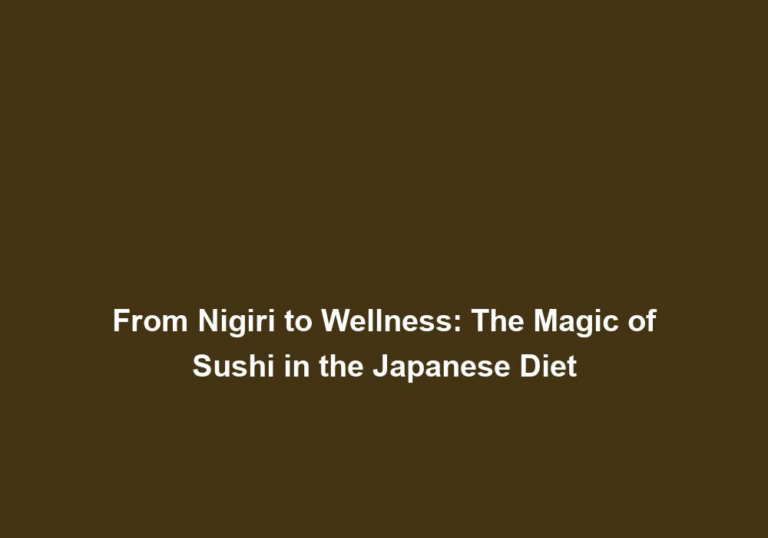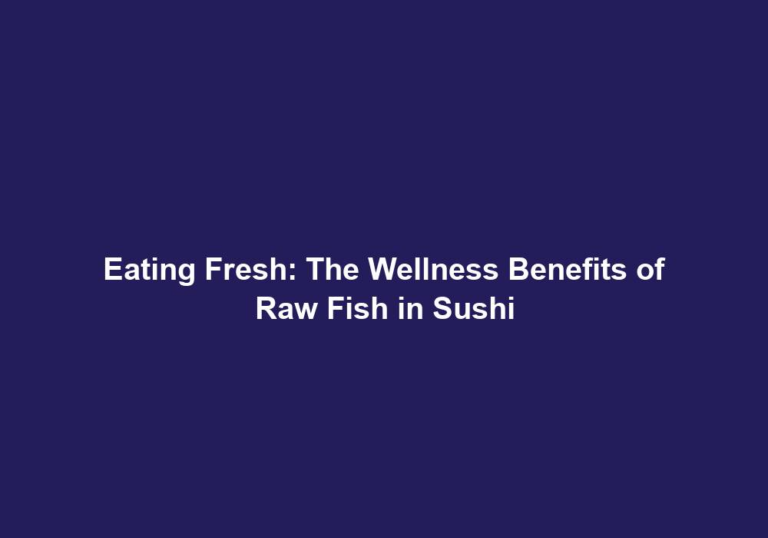Exploring the Japanese Diet: Health and Harmony on a Plate
The Japanese diet is renowned for its emphasis on health and harmony. With a rich history and deep-rooted traditions, the Japanese have mastered the art of creating balanced and nutritious meals that not only satisfy the taste buds but also promote overall well-being. In this article, we will delve into the various aspects of the Japanese diet and discover the secrets behind its health benefits and the principles it follows.
The Foundation of the Japanese Diet
Rice: The Staple Food
Rice forms the cornerstone of the Japanese diet and is a crucial component of almost every meal. It is low in fat and cholesterol, high in carbohydrates, and provides essential nutrients such as vitamins, minerals, and dietary fiber. The Japanese traditionally consume short-grain white rice, which is sticky in texture and pairs well with other dishes.
In addition to being a source of energy, rice also contains important nutrients that contribute to overall health. It is a good source of B vitamins, which play a vital role in metabolism and energy production. Rice also provides minerals such as magnesium and selenium, which are essential for various bodily functions.
Furthermore, the consumption of rice in the Japanese diet is often accompanied by a variety of side dishes, which further enhance the nutritional value of the meal. These side dishes typically include vegetables, fish, and soy-based products, providing a well-rounded and balanced diet.
Fish and Seafood: The Protein Powerhouses
Seafood plays a significant role in the Japanese diet, providing high-quality protein and important omega-3 fatty acids. Fish like salmon, mackerel, tuna, and sardines are abundant in Japan and are often consumed raw (sashimi) or cooked. The omega-3 fatty acids found in seafood help reduce the risk of heart disease, improve brain function, and promote healthy skin.
In addition to being a rich source of protein, fish and seafood also provide important nutrients such as vitamins D and B12, iodine, and selenium. These nutrients are essential for various bodily functions, including immune function, brain health, and thyroid function.
The consumption of fish and seafood in the Japanese diet is not only beneficial for health but also adds a unique flavor profile to the meals. The Japanese have mastered the art of preparing fish and seafood in various ways, such as grilling, steaming, and simmering, which enhances their natural flavors and textures.
Vegetables: The Nutrient-Rich Goodness
The Japanese diet focuses heavily on vegetables, which are consumed in various forms – raw, steamed, grilled, or pickled. Vegetables like seaweed, cabbage, spinach, and daikon radish are packed with vitamins, minerals, and antioxidants that support overall health and boost the immune system. The variety of vegetables ensures a wide range of nutrients and flavors in Japanese cuisine.
Vegetables in the Japanese diet provide a wide array of nutrients, including vitamins A, C, and K, folate, potassium, and fiber. These nutrients are essential for maintaining healthy skin, supporting immune function, regulating blood pressure, and promoting digestive health.
Moreover, the Japanese incorporate a variety of cooking techniques to prepare vegetables, which not only retain their nutritional value but also enhance their flavors. Steaming, grilling, and stir-frying are common methods used to cook vegetables, ensuring that they are cooked to perfection while preserving their nutrients.
Soy: The Plant-Based Protein
Soy-based products are another essential part of the Japanese diet. Tofu, miso, and soy sauce are commonly used ingredients that provide plant-based protein. Soy is a rich source of amino acids, and its consumption has been associated with a reduced risk of heart disease, certain cancers, and osteoporosis. Tofu, made from soybeans, is a versatile ingredient that can be incorporated into various dishes, both savory and sweet.
In addition to being a source of protein, soy-based products also contain other beneficial compounds such as isoflavones, which have been shown to have antioxidant and anti-inflammatory properties. These properties may contribute to the prevention of chronic diseases and the promotion of overall health.
Soy-based products are widely used in Japanese cuisine to add flavor and texture to dishes. Tofu, for example, can be used as a meat substitute in stir-fries or as a dessert ingredient in custards and puddings. Miso, a fermented soybean paste, is used as a seasoning in soups and sauces, adding depth and complexity to the flavors.
Traditional Japanese Cooking Techniques
Steaming: Preserving Nutrients and Flavor
Steaming is a popular cooking technique in Japanese cuisine that helps retain the natural flavors and nutrients of the ingredients. It involves cooking food over boiling water, which gently cooks the food without leaching out essential nutrients. Steaming is commonly used for vegetables, seafood, and even desserts, resulting in a light and healthy meal.
Steaming is a gentle cooking method that helps preserve the nutritional content of the ingredients. It minimizes the loss of water-soluble vitamins, such as vitamin C and B vitamins, which are prone to degradation when exposed to high heat. Steaming also helps retain the natural colors and textures of the food, resulting in visually appealing dishes.
In addition to its nutritional benefits, steaming also enhances the flavors of the ingredients. By cooking the food in its own steam, the natural flavors are intensified, resulting in a more vibrant and delicious meal. Steamed vegetables, for example, retain their crispness and freshness, while steamed fish becomes tender and moist.
Grilling: Enhancing Flavors and Texture
Grilling, known as yakimono, is extensively used in Japanese cooking to add smoky flavors and create a crispy exterior while maintaining the juiciness of the food. It is commonly used for fish, meat, and vegetables, enhancing their natural flavors and creating a delightful texture. The Japanese often use charcoal grills, called sumiyaki, to achieve the desired smoky taste.
Grilling adds a unique depth of flavor to dishes, thanks to the Maillard reaction, which occurs when proteins and sugars in the food react to heat. This reaction creates a range of complex and savory flavors, giving grilled dishes a distinct taste profile. The smoky aromas from grilling also contribute to the overall sensory experience of the meal.
Moreover, grilling helps create a desirable texture in the food. The high heat of the grill caramelizes the surface of the food, resulting in a crispy exterior that contrasts with the tender interior. This contrast in textures adds an enjoyable mouthfeel to the dish, making it a pleasurable eating experience.
Fermentation: Unlocking Health Benefits
Fermented foods are highly valued in the Japanese diet due to their numerous health benefits. Fermentation not only enhances the flavor of the ingredients but also increases their nutritional value. Foods like miso, soy sauce, and pickled vegetables undergo fermentation, which promotes the growth of beneficial bacteria, aids digestion, and improves gut health.
During the fermentation process, beneficial bacteria, such as lactobacilli, convert sugars into lactic acid, creating an acidic environment that inhibits the growth of harmful bacteria. This process not only extends the shelf life of the food but also enhances its flavor and texture. Fermented foods often have a unique tangy or umami taste, which adds complexity to dishes.
Additionally, fermented foods are rich in probiotics, which are beneficial bacteria that support a healthy gut microbiome. A healthy gut microbiome is associated with various health benefits, including improved digestion, enhanced immune function, and reduced risk of certain diseases.
Portion Control and Mindful Eating
The Japanese approach to food goes beyond the ingredients and cooking techniques; portion control and mindful eating play a significant role in their diet.
Hara Hachi Bu: Eating Until 80% Full
The Japanese practice hara hachi bu, which translates to eat until 80% full. This mindful approach to eating prevents overeating and allows the body to fully digest the food, thereby promoting better digestion and weight management. By stopping before feeling completely full, the Japanese maintain a balance between satisfying hunger and avoiding excess consumption.
Hara hachi bu is deeply rooted in Japanese culture and is often practiced as a way to show respect for food and avoid wastage. It encourages individuals to listen to their bodies’ signals of hunger and fullness, promoting a healthier relationship with food. By eating until 80% full, individuals can enjoy their meals without feeling uncomfortably stuffed or deprived.
Slow and Steady Meals: Savoring Each Bite
Japanese meals are typically served in multiple small dishes, encouraging slower eating and appreciation of each bite. This practice allows for better digestion, prevents overeating, and provides a more enjoyable dining experience. Eating slowly also helps the brain register satiety, reducing the chances of overeating.
The concept of slow and steady meals in Japanese culture emphasizes the importance of savoring each bite and being fully present during mealtimes. It encourages individuals to pay attention to the flavors, textures, and aromas of the food, enhancing the overall sensory experience. By eating slowly, individuals can fully enjoy their meals and feel more satisfied with smaller portions.
Conclusion
The Japanese diet offers a holistic approach to health and well-being through the principles of balance, variety, and mindfulness. By incorporating nourishing ingredients, traditional cooking techniques, and an emphasis on portion control, the Japanese have achieved a diet that promotes longevity, supports overall health, and brings harmony to the plate. Whether it’s the consumption of rice, fish, vegetables, or the mindful eating habits, the Japanese diet sets an example of how food can be both delicious and incredibly beneficial for the body and mind.







